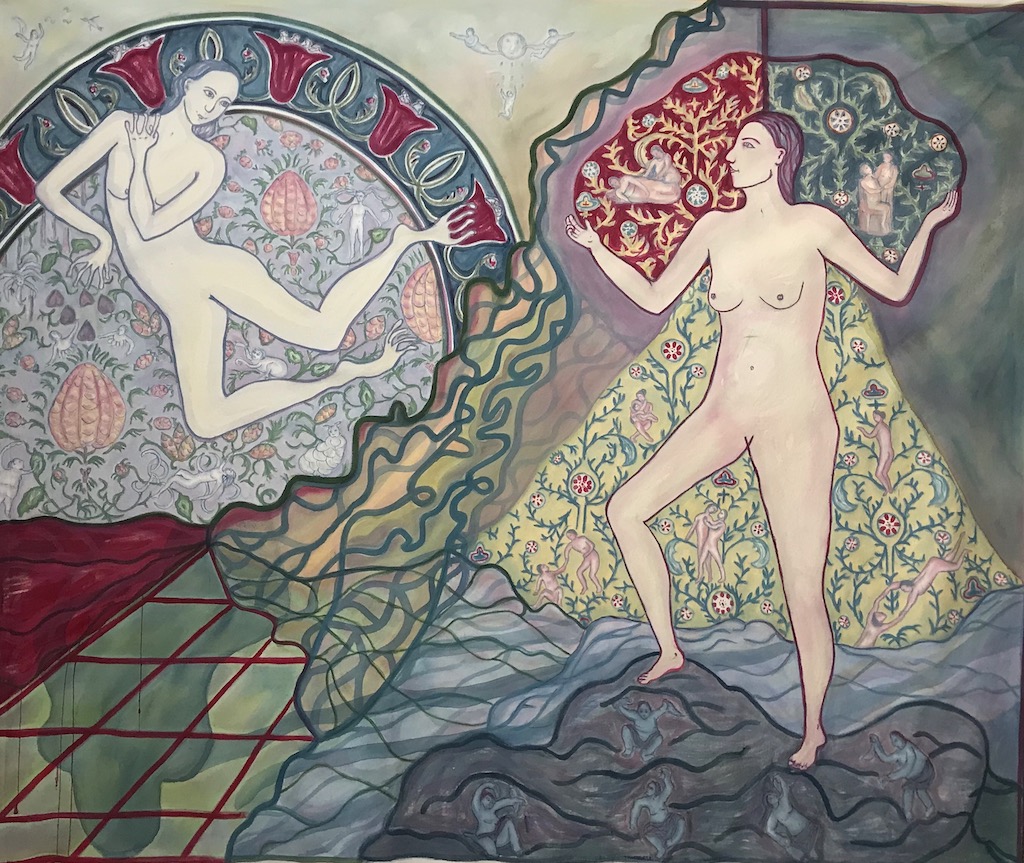
About Another glad day
I always resist referencing specific people, the figures in this painting are created as avatars, not stereotypes, These two main figures, one hybrid with distorted froglike fingers and toes, the other is standing on a rock a little like a Caspar David Friedrich rucken figure from the front, she is not however signalling that she has conquered or owns the landscape, as she also nods to William Blake’s Glad Day 1794-6 (often called ‘Albion Rose’).
Both figures are naked, communicating connectedness and vulnerability and power. They are ‘in the grip of convention and rationality the figure is stripped of clothing and has cast off the material world to welcome a new dawn ‘(Blake). Well a slightly sardonic ‘new dawn’: switching the gender of these powerful symbols doesn’t change a patriarchal world in which both nature and women are owned, controlled, and shaped to greedy needs, yet exposing devious cultural appropriations of both is a start.
New paintings explore fictions and polyphonic stories, exploring and interrogating local terrain, aiming to show how reflexive processes of embodiment create new stories that turn history and hierarchies inside out. Landscape and nature is expressive of specific cultural meanings and here in Cornwall local places are indicative of a myth of wildness and marketed as such. Yet natural phenomenon and places can stand for many things. The landscape and rock references in this painting are specifically from Treen, near the now famous Minack Theatre, built on the myth of a woman who with her bare hands created theatre on the edge of cliff. Her story amplified, appropriated, owned and sold on to others. The theatre-landscape of Treen is no longer be truly ‘wild’, if it ever was, so lets tell different stories about it.
Paintings aim to re-create familiar beauty, strangeness, and ambiguity with significant stories residing in pattern. Full of tiny figures that tell stories of inequality, poverty and caring roles, there are also stories of transformation; metamorphosing hybrids, troll-like rock dwellers, fae-like flower-dwellers. Their stories can be pieced together like the land and they ask that we look below the surface to where they might reflect back to us purpose and belonging.Underpinned by nature, land is a physical pattern, an invisible web that creates a filigree of rich understanding between people, and similarly the domesticated patterns of the lives of women are full of myths about the value of care. Both nature and women have historically been oppressed and devalued, paintings aim to visually weaving new stories into culture about the value of the role of care, and life-giving.
The main hybrid figure gestures generously and exultantly above patterns of pomegranate that traditionally symbolises women and their power over life and death. Pattern is used to renew old symbolism, re-tell old stories and create new juxtapositions that counter-act the invisibility of women, mothers and carers. Hybrids and monsters are beautiful and disturbing; pleasing and grotesque. Metamorphosing figures occupy a gap or an interval ‘between what has been and becoming [something other]’.
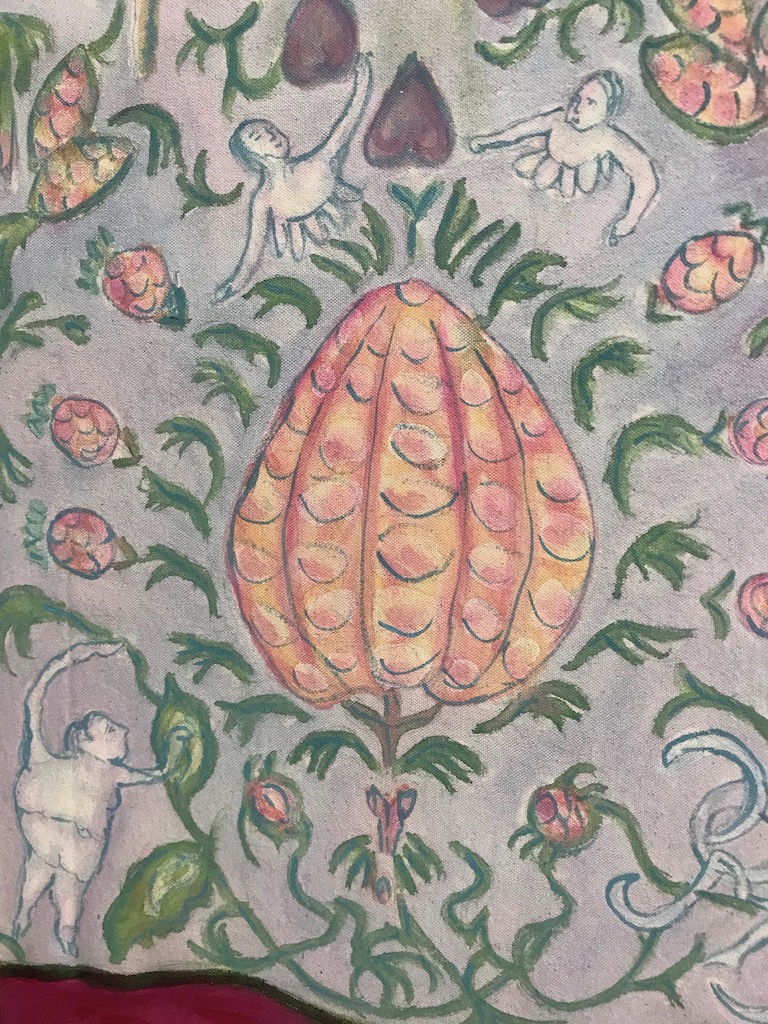
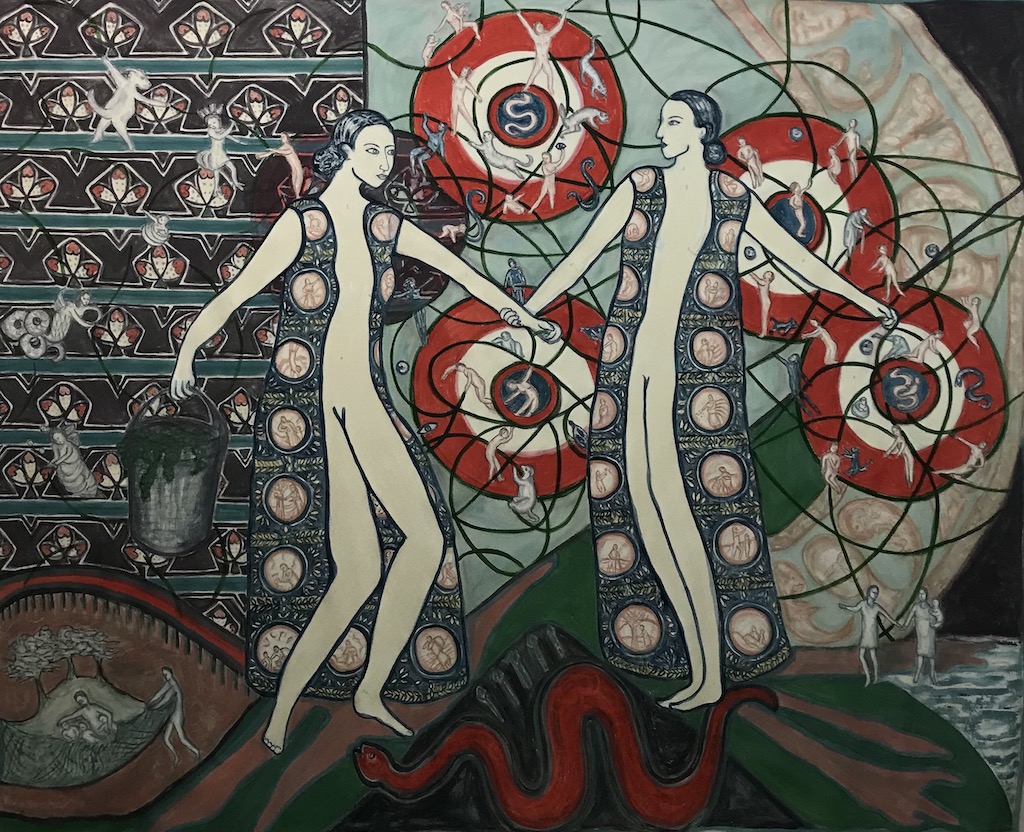
About A common treasury for all
In 1649 a group of between twenty and thirty poor men and women began to dig the earth on St George’s Hill in Surrey. According to a government spy, ‘They invite all to come in and help them, and promise them meat, drink and clothes. . . . They give out, they will be four or five thousand within ten days. . . . It is feared they have some design in hand’.
Winstanley inspired the Diggers, a remarkable movement for land sharing and land rights, especially for its time. ‘A common treasury for all’ was part of his universal message of equality; access which envisioned an ecological interrelationship between humans and nature, acknowledging the inherent connections between people and their surroundings.
Perhaps even more remarkable for its time was that they allowed women some rights too. Whilst women have been historically symbolically represented as closer to nature because of their bodily function of reproduction (and also as something to be tamed and controlled) women have had few rights over the natural spaces around them. Women’s relationship with the land is complicated but then women lead complicated lives especially if they have family and domestic responsibilities. Home and hearth were their usual sphere of influence. Land girls during the Second World War were a rare exception in a history of absence in land working and land owning, but the war was soon over women were told to go back home to the kitchen sink.
In Britain where only 5% of the population own the majority of land and there is no ‘right to roam’ access to land the countryside is still very much contested and ‘rights of way’ become a great metaphor for the equality and freedom of women. Weaving these ideas with ecological and societal care, recent work explores redefining women’s relationships with landscape, nature and place, and giving them a central role.
Surreal ‘out of place’ juxtapositions between domestic and landscape explore domestic work and care; performing the body and interior stories ‘outside’, beyond domestic enclosures is subversive. Confronting, destabilising and transfiguring stereotypical stories and associations between women, nature and domesticity transcends domestic ‘bounds,’ and creates multi-layered fluid terrains of typically invisible Subjects.
A common treasury for all is a painting aiming to create an aesthetic of interconnectedness, social responsibility and ecological attunement.
Barbara Bolt writes of ‘painting as an event, a ‘summoning forth’. I wanted to create a ‘dynamic, entangled in counterpoint movement’ and ‘move in and out [of]… pictorial possibilities’, to create a chaotic yet connected profusion of figures. Using a limited palette of colours, figures and patterns are criss-crossed with green lines that are constellations and conjunctions between; the main figures lead an army of patterns in which figures invade and act. Even their clothing contain ‘interwoven information fields; with further figures. In total there are 48 figures in the patterns and landscape, and 34 more in the clothing.
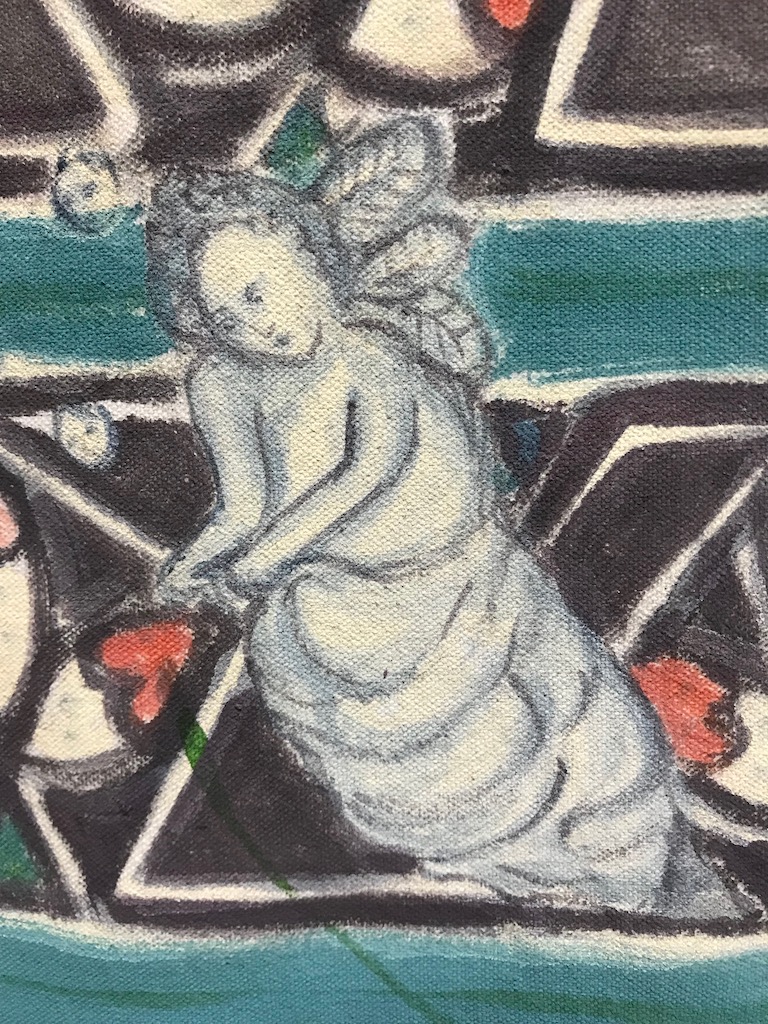
This cast of approximately 100 figures, they all forge a ‘relationality-between’; proposing a dynamic view of women and a principled equality of Subjects in space. Snakes are utilised as a symbol of change and transformation. They are no longer a biblical indictment of women (through the temptation of Eve by a snake), snakes symbolise women’s potential for change and metamorphosis.
Moving through time and space, women can be free to choose how to represent themselves. Representing the value of care and compassion is the root of a vision of the world where women are gatekeepers, not only for the birth and care of future generations, but for caring for what really matters to the future of human kind. It is almost unimaginable to dream of how the world might change if this philosophy was adopted by all ‘mankind’.
Delpha Hudson, January 2024
Do get in touch if you would like more information about paintings.
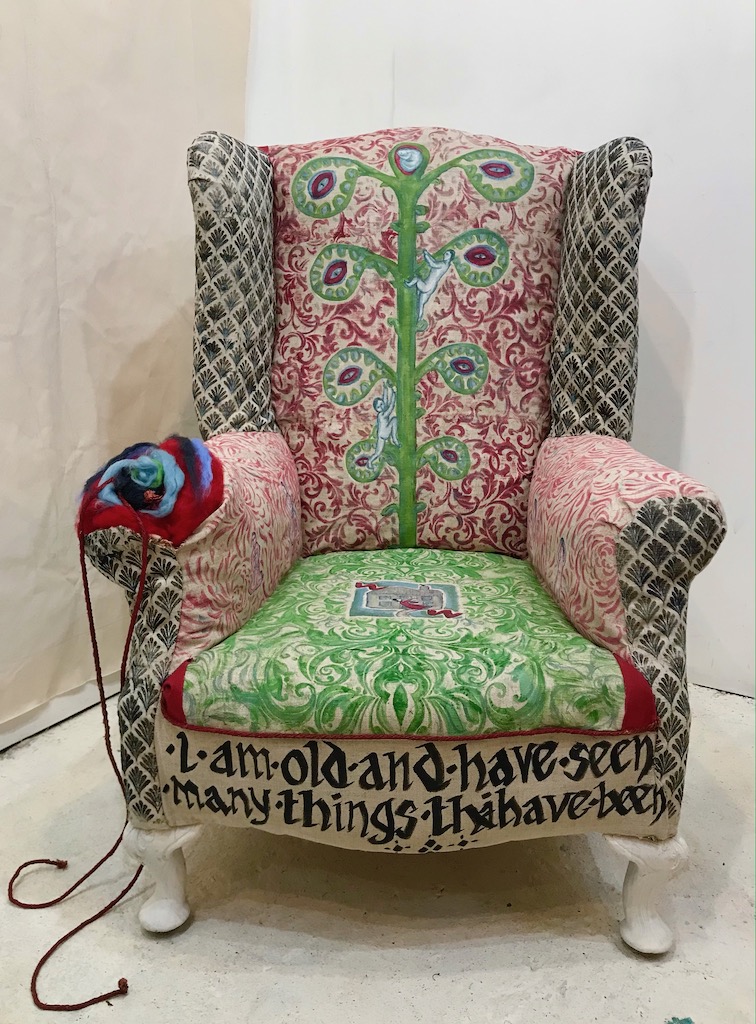
Read about this interactive painting installation shown at Tremenheere sculpture gardens gallery, 2024.
Work on paper, 2024
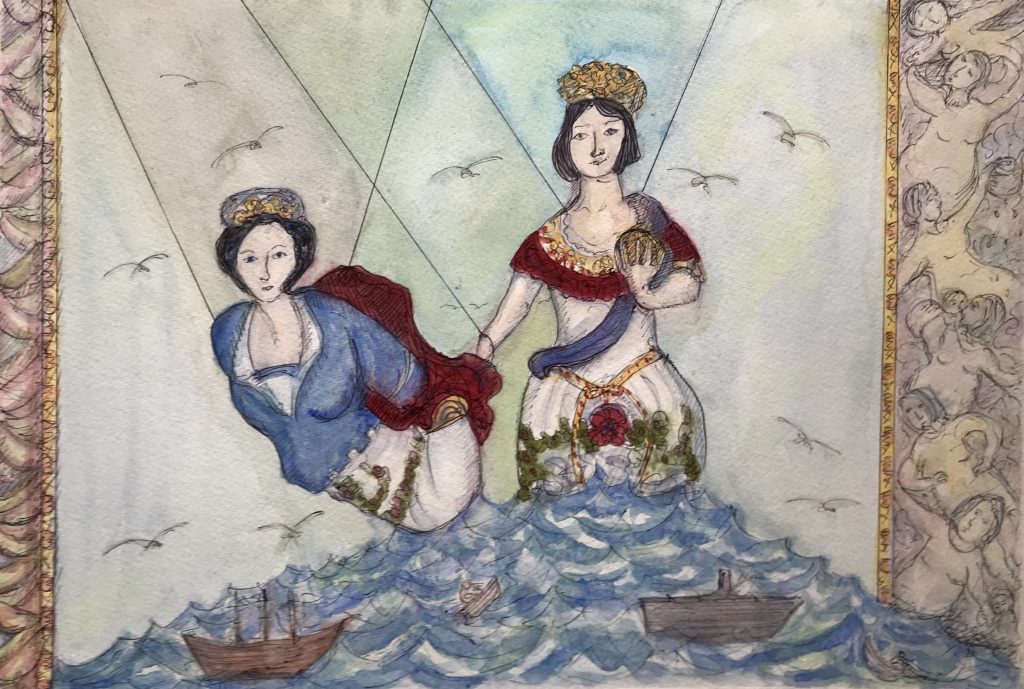
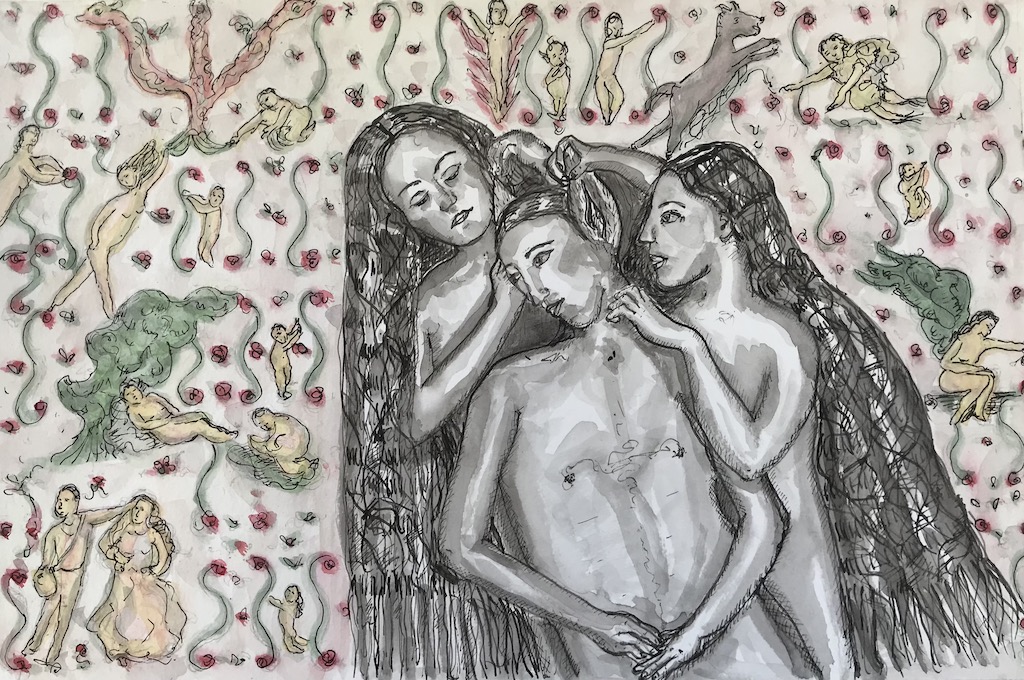
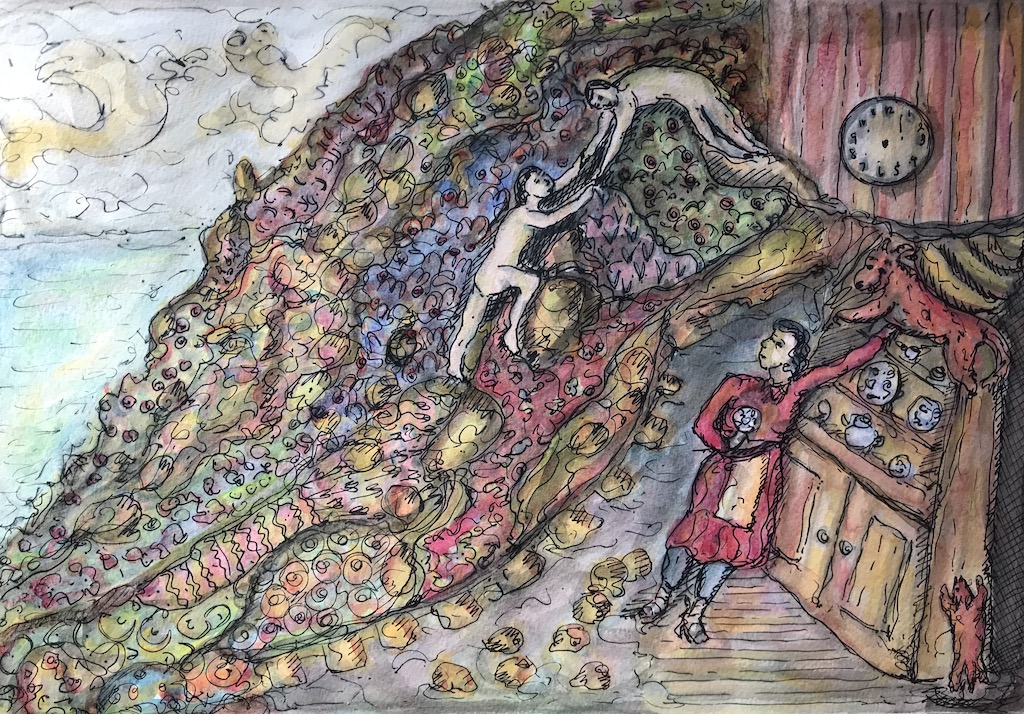
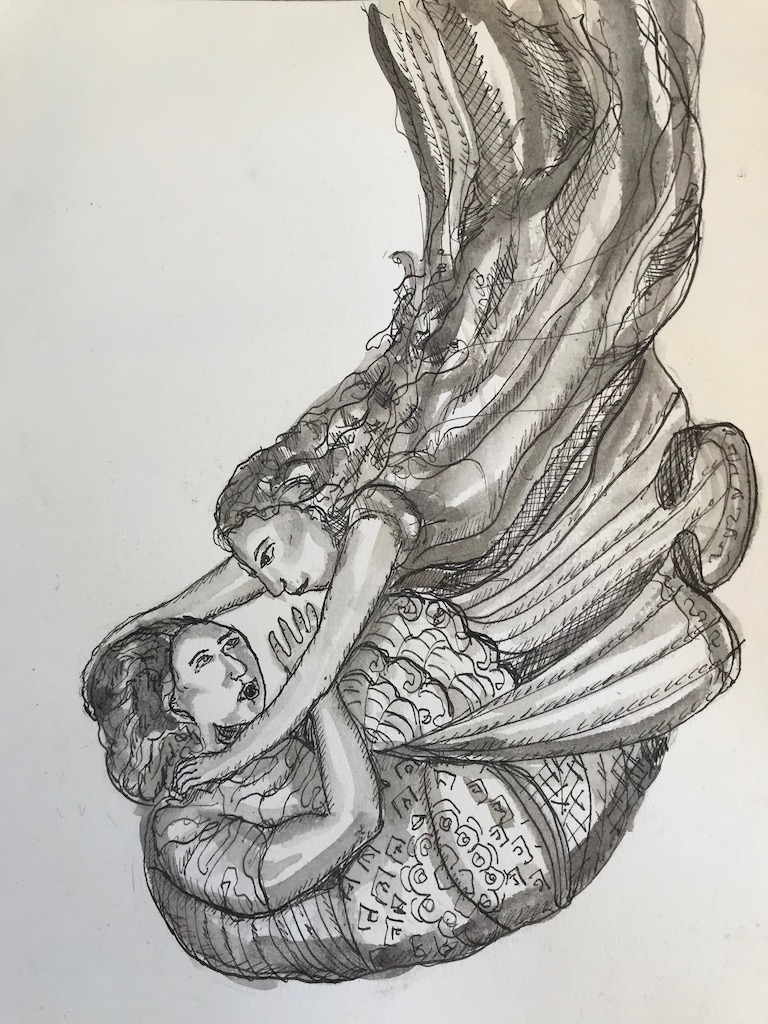
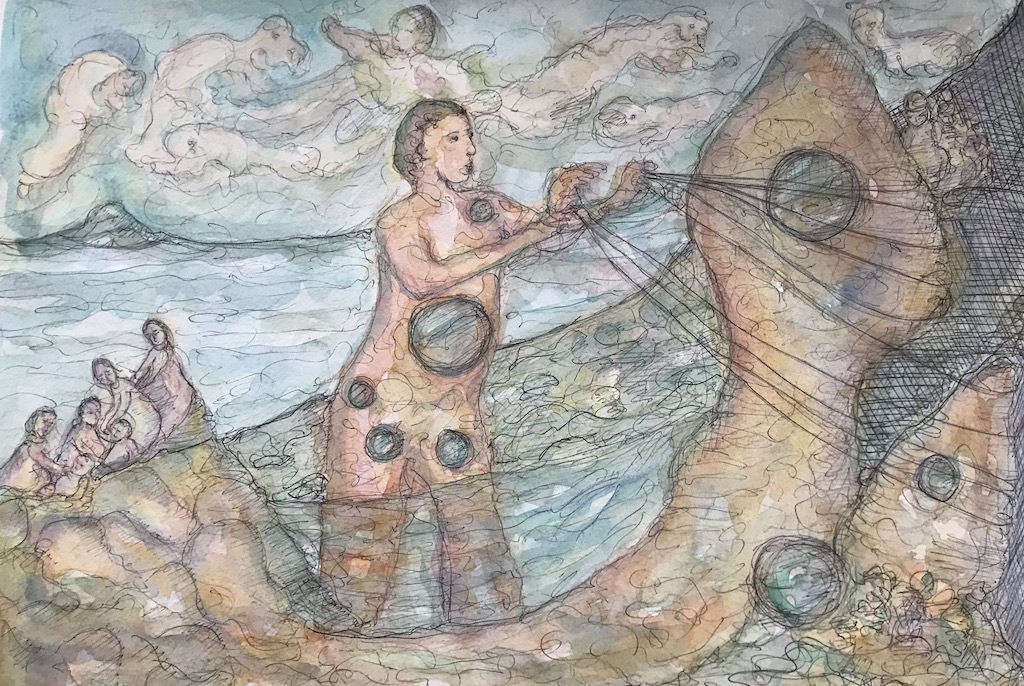
Some notes on the use of opaque and translucent figures & porosity
The most opaque colour is white, it does not absorb light giving the impression of purity and luminosity. We cannot see light, we rely on the impression of absence and of depth and shadows. Like a mirror white cannot be seen through.
I use the opaque lightness of figures to explore visibility and absence, yet also try to balance it with translucency. The figures are white with the merest hint of depth and shadow. They are both ‘opaque’ and ‘translucent’; both full of light and yet porous. Porosity interests me as women its seems are often more permeable than men. Porosity and permeability have been used to describe the ability of humans to think of others, to have fewer boundaries and greater empathy. I love the seeming contradiction of working with opacity and translucency; impermeability and porosity.
As a way of evoking connectedness, these female figures are visible and meld into their landscapes in many ways communicating the loss of self through others. Something the human race depends on yet is often given by women at huge personal loss.
Seeing through and being seen was inspired by porous rocks of the Algarve coast, Portugal. View other work inspired by ancient landscapes and rocks or look at other works on paper.
For all the latest news connect to Delpha on instagram @delphahudson